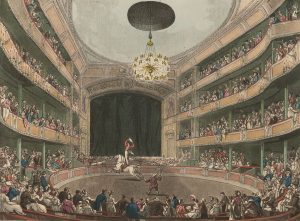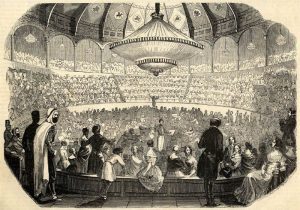Astley’s Amphitheatre
 Nel 1766, dopo aver combattuto la Guerra dei Sette Anni, il sergente maggiore di cavalleria Philip Astley decise di intraprendere la strada dell’equitazione acrobatica esibendosi in svariati giardini (tra i più noti troviamo Vauxhall e Ranelegh). Nel 1768 Astley aprì una propria scuola di equitazione a Lambeth, vicino a Westminster Bridge presso la quale durante il giorno teneva le lezioni, mentre durante il pomeriggio e la sera si esibiva con diversi trucchi all’interno del “ring”.
Nel 1766, dopo aver combattuto la Guerra dei Sette Anni, il sergente maggiore di cavalleria Philip Astley decise di intraprendere la strada dell’equitazione acrobatica esibendosi in svariati giardini (tra i più noti troviamo Vauxhall e Ranelegh). Nel 1768 Astley aprì una propria scuola di equitazione a Lambeth, vicino a Westminster Bridge presso la quale durante il giorno teneva le lezioni, mentre durante il pomeriggio e la sera si esibiva con diversi trucchi all’interno del “ring”.
Da abile uomo d’affari quale era, Astley aveva svolto numerose e approfondite ricerche di mercato. Aveva visitato i principali teatri Londinesi e notato come il pubblico fosse attratto in modo particolare dagli intermezzi aggiunti ai comuni spettacoli a cavallo, come numeri di clown e di giocoleria, e performance di acrobati.
 Astley colse l’occasione di rendere queste esibizioni, considerate secondarie, e spesso eliminate dalle locandine dei teatri, il centro dell’intrattenimento affiancandole alle performance delle troupe equestri, già molto apprezzate dal pubblico. Questa idea si rivelò vincente quando, in seguito all’apertura di un palcoscenico a cielo aperto a sud di Westminster Bridge, Astley riscosse fin da subito un enorme successo.
Astley colse l’occasione di rendere queste esibizioni, considerate secondarie, e spesso eliminate dalle locandine dei teatri, il centro dell’intrattenimento affiancandole alle performance delle troupe equestri, già molto apprezzate dal pubblico. Questa idea si rivelò vincente quando, in seguito all’apertura di un palcoscenico a cielo aperto a sud di Westminster Bridge, Astley riscosse fin da subito un enorme successo.
Dopo il successo ottenuto, Astley aprì un secondo edificio a Parigi (il Manège Anglais, successivamente conosciuto come Amphithéâtre Anglais) e successivamente un terzo a Dublino.
Tra le principali problematiche che Astley dovette affrontare vi furono: la competizione, la perdita del teatro parigino e il rischio di incendio. Nel 1782, un ex impiegato di Astley, Charles Hughes, costruì un edificio con l’intento di sfidare l’Astley, non molto lontano dall’Anfiteatro stesso, che chiamò Royal Circus. Questo, però, non ebbe vita lunga e, alla fine del secolo, sparì a causa degli enormi debiti e delle continue faide. Il secondo problema fu la perdita del teatro parigino (in seguito alla rivoluzione) che venne poi ripristinato nel 1802 con la Pace di Amiens. Il terzo problema fu il rischio di incendio. L’anfiteatro venne distrutto dalle fiamme una prima volta nel 1794, mentre Astley era in servizio con il suo vecchio reggimento, e una seconda volta nel 1803.
A seguito della morte di Astley nel 1814 e del figlio, avvenuta sette anni dopo, l’Anfiteatro fu gestito da diverse personalità (tra le più famose ricordiamo quelle di Andrew Ducrow, i fratelli Sanger e William Batty) fino al 1893, anno in cui venne demolito.
Sitografia
https://londonhistorians.wordpress.com/2011/01/12/philip-astley-founder-of-the-modern-circus/ Paterson, Mike. “Philip Astley: Founder of the Modern Circus”, London Historians’ Blog, 2011. [ultima consultazione il 01/05/2019].
https://vauxhallhistory.org/astleys-amphitheatre/ “Astley’s Amphitheatre”, Vauxhall History, 2012. [ultima consultazione il 01/05/2019].
English Version
Astley’s Amphitheatre
In 1776, the master sergeant of Cavalry Philip Astley, after his fight into the Seven Years’ War, gave life to a series of equestrian vaulting exhibitions in various gardens (among the most famous we remember Vauxhall and Renelegh). In 1768 Astley founded his riding school in Lambeth, near Westminster Bridge, during the day he used to give lessons while in the night he performed different shows into the “ring”.
He was an entrepreneur, in fact, he did various and deep market researches. He went to the principal theatres in London and figured out how the public was particularly attracted to the entr’actes, which used to take place between the acts of the main equestrian drama. Entr’acts were mainly juggling shows of and acrobats9 performances.
Astley wanted to give a superior emphasis on these exhibitions, considered less important and often removed from the theatre’s posters. His aim was to turn these exhibitions into the core of the evening entertainment, together with the performances of equestrian troupe, already largely appreciated by the audience. This idea turned out to be successful after the opening of an open-air stage, south of Westminster Bridge.
After his success, Astley opened a second building in Paris (called Manège Anglais and later known as Amphithéâtre Anglais) and then third one in Dublin.
Astley had to deal with different problems such as the competition, the loss of the Parisian theatre and the risk of fire. First of all, in 1782 Charles Hughes, one of Astley’s ex worker, erected a building similar to Astley’s amphitheater, which he called Royal Circus, in order to challenge him. Unfortunately, the Royal Circus did not have a long life; at the end of the century, it shut down because of debts and many incessant feuds. The second problem was the loss of the Parisian theatre right after the revolution – then re-established in 1802 with the Treaty of Amiens. The third problem was related to fire hazard, the amphitheater was destroyed by flames the first time in 1974, while Astley was working with his old regiment, and the second time in 1803.
After Astley’s death in 1814, and the death of his son seven years later, the amphitheater was managed by different personalities such as Andrew Ducrow, Sanger brothers and William Batty until 1893, the year of its demolition.
